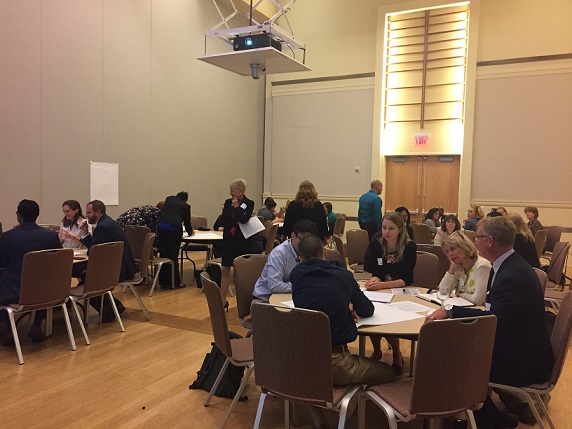Let us know what type of content you'd like to see more of. Fill out our three question survey.
Open Innovation in 60 Minutes or Less
Oct 4, 2017
When we do “open innovation,” it’s essential to define the problem we are trying to solve. And crucial to that process is crafting a good “Call.” Can this be done in 60 minutes or less?

DAI facilitated workshop on open innovation at the Triangle Global Health Conference in Raleigh, North Carolina.
At the recent Triangle Global Health Conference, Director of Digital/ICT Krista Baptista and I tried our luck. We started our workshop by giving participants an overview of open innovation and when we use it. We outlined the benefits of using open innovation to systematically source solutions from a variety of people and groups, and we allowed participants to test the process themselves. But instead of asking them to be the “innovators,” or responders to the Call, we asked them to imagine being the organization searching for external solutions. How do you ask others to provide solutions to problems that have, in this case, plagued the public health space for decades? Put simply, how do you draft a good “Call?”
What Is a Call?
The Call is a key element of an open innovation competition. Its contents determine the types of solutions that will be put forward and who will provide them. Using the U.S. Global Development Lab’s Tools for Innovation Programming, we outlined the basic components of a successful Call. They include:
-
A well-defined problem.
-
The barriers that actors are struggling to overcome and what change or impact may be critical in addressing the problem.
-
A concise logic statement, such as: “We are seeking innovations that overcome, leapfrog, or circumvent X barrier to achieve Y outcome.”
-
The criteria that generally characterize what a successful innovation should achieve, or what criteria will be used in the evaluation.
We then gave them a problem—lack of access to medical supplies in rural health clinics. This problem was intentionally vague, allowing participants to define the specifics based on their expertise. In a room full of public health practitioners and experts this was not too difficult. The only restriction we imposed was that participants had to call for digital solutions.
Perhaps the most valuable part of the exercise was the time spent in groups brainstorming about and then drafting the Call. The participants each had different experiences with the problem and were able to amalgamate their perspectives into one concise Call—an example of healthy co-creation early on in the process.
Common Challenges with Drafting Calls
After 30 minutes, we brought the groups back together to present their Calls. Their products illustrate some of the issues involved in looking for external solutions to a problem that you know so well. For example, it is extremely difficult to stop thinking about the solutions and potential actors that could deliver them. One group suggested in their logic statement to use drones to deliver medical supplies. Another group called for a partnership between Amazon and UPS to improve delivery to rural areas in the United States. By stating exactly what and who they were looking for, these groups counteracted the purpose of open innovation. Other groups, though, were able to draft the Call without steering potential respondents in a certain direction. We then had a panel of experts—including IntraHealth’s Director of Digital Health, Wayan Vota; North Carolina State’s Associate Dean for Research in the College of Natural Resources, Marian McCord; and DAI’s Global Health Practice Lead, Kirsten Weeks—evaluate the groups to determine which one best addressed the components of an effective Call. The winning team’s Call is included here:

Open Innovation Call
Understanding open innovation and designing a competition to respond to a well-defined problem does take time, but a 60-minute workshop can illuminate the opportunity that open innovation presents, the typical problems we often face when using it, and how to get started drafting the Call.